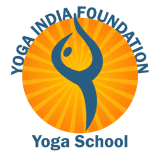What is yoga?
The word Yoga is derived from the Sanskrit root „Yuj“, meaning to join, to unite.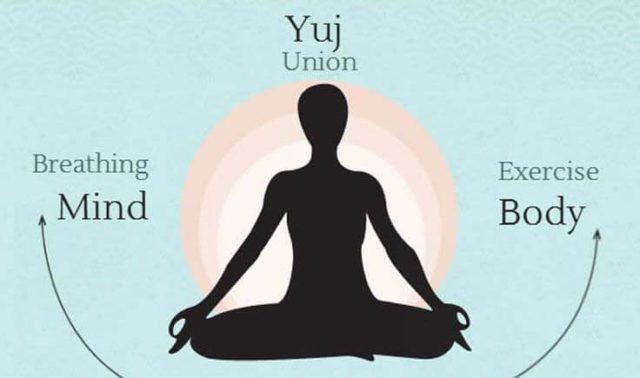
It is a system of breathing exercises, physical and spiritual disciplines, all originally designed to
bring the yogi to samadhi – the state of enlightenment.
As yoga offers a holistic approach to life, its teachings can be very valuable to modern society.
In ordinary western schools, you do not learn what to do if you feel fear, anger, or frustration. You do
not understand what they are or where they come from. You do not know what it is to eat really
healthy. You do not learn what it means to keep your body in good shape and physical health and
why that also is important for your mental wellbeing. No curriculum in an ordinary school makes it a task to learn according to which values to live to become a happy person unless you
have a very dedicated and wise teacher who makes the teaching of this knowledge his personal
mission.
Asanas
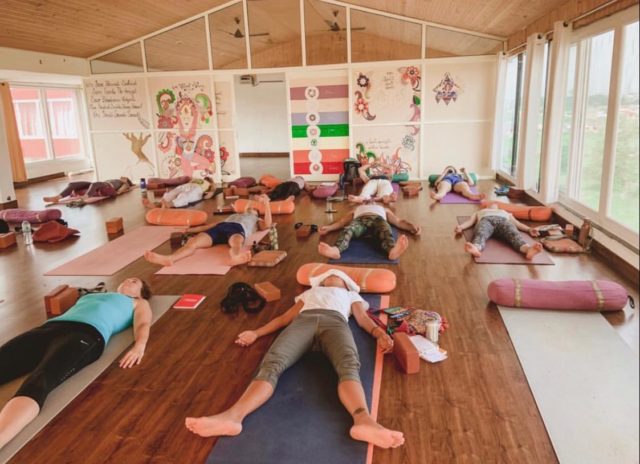
Yoga offers to teach about all of this. In western society, it is most known for its Asanas, the
body postures. The main groups of Asanas are forward bends, backbends, twists, inverted postures, and balancing poses. Here are examples for three different Asanas you might have seen before:
Tree pose, Vrksasana (balancing pose)
For the tree, pose come into the standing pose, sasmastithi. Take one leg up, grasp the ankle of the foot and
place the sole of your foot on the inside of the thigh of the standing leg. If it is hard for you to do
that, then place the foot under your knee on the inside of the lower leg. Don’t place it on your knee.
Try to have your hips in line, not one side stretching out to the side, don´t arch your lower back.
Engage the muscles of your standing leg and your buttocks. Lift your sternum. Have your hands in
namaste in front of your chest, then stretch them over your head. Enlongate the spine. Focus your
eyes on a point in front of your body to keep balance. Breath normally. Hold for up to minutes.
Always do both legs.
Wheel, Chakrasana (backbend)
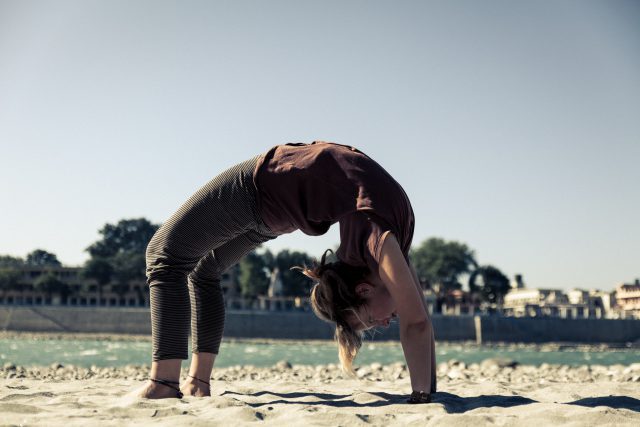
Lie on your back. Bend your legs and put your heels right behind your buttocks (if you are a
beginner, then one-foot length away or start with the bridge), hip-width apart meaning the outer side
of your feet is in line with the outer part of your thighs. Place your palms beside your ears,
fingers facing down towards your shoulders. Engage your core, tilt your pelvis towards the ceiling.
Now inhale and with the exhale come to the crown of your head. When you’re ready, inhale again, and
with the next exhale lift your head and heels, so you stand on your toes first. Then slowly lower your
heels and try to maintain the same arch in your body. Breathe normally. Press through the inside of
your feet. Do not let the knees fall outwards. Try to press your knees towards the chest, try to
straighten the knees and the arms more. Engage your core, press your buttocks up, open your chest.
Breathe. Hold as long as comfortable. Come down slowly and rest. Then try again. Practice up to 3
times after one another. Then counterpose with a careful forward bend. Now you can go to child pose
and then to a counterpose such as tabletop pose and/or downward dog.
Headstand Sirshasana (inverted pose)
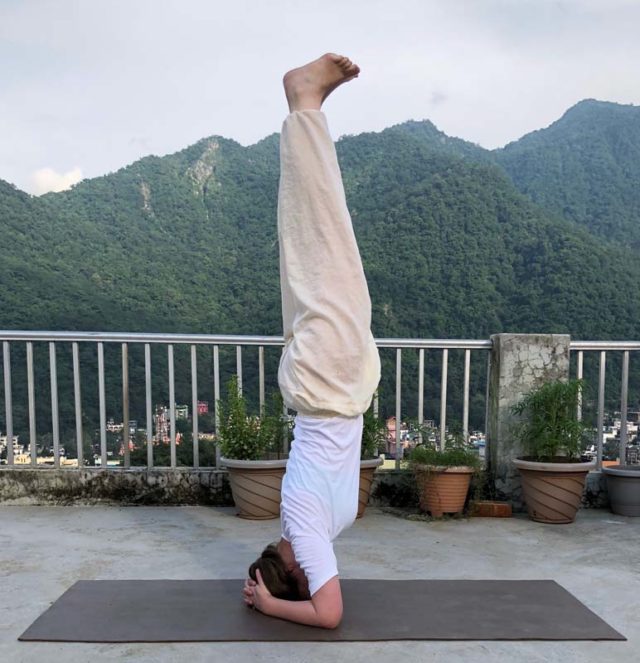
Sit in Vajrasana. Place your forearms on the matt in front of you shoulder-width apart. Interlock your
fingers and place the pinkie – side of your hands in front of you on the matt. Your forearms form a
triangle now. Don’t move your elbows out or in. Hold them in line with your shoulders. Place the
crown of your head between your hands, wrap them around your head to give support. Lift your
knees and buttocks from the matt, walk the feet towards your elbows while gradually bringing
your back in a vertical position, the buttocks the highest point. Now bend the knees and gradually
raise the lower legs towards your buttocks. Try to find and maintain balance in this position before
you stretch your legs fully. Toes pointing towards the ground. Try to have your weight on your arms,
not on your head. Lift your shoulders, don’t collapse them. Try to not arch your back too much,
engage your core muscles. Hold this position as long as possible. Then slowly come down and rest
in child pose.
It has been proven that the practice of the Asanas can already have a positive effect on blood flow,
depression and fear-based mental conditions, back pain, and insomnia to name just a few. It improves
your flexibility and strengthens your body. It massages inner organs and can improve digestion,
headache, and blood pressure. But oftentimes they are practiced like exercises, pure body posture,
and the knowledge which otherwise can be gained through studying yoga is not communicated by
most western teachers.
Asanas/Ayurveda
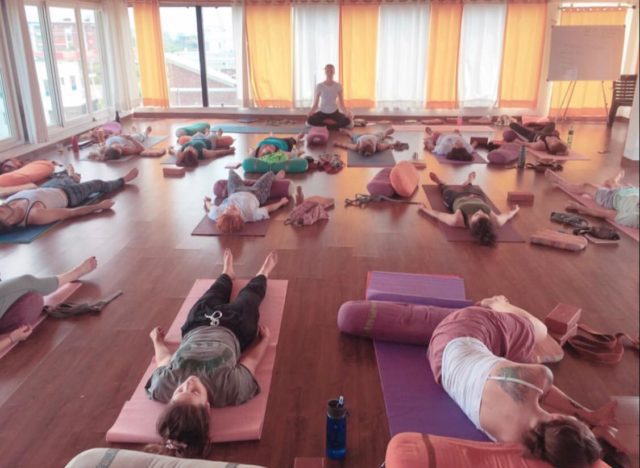
Apart from the purely physical realm of the Asanas, there is a whole other world to it if you apply the
ayurvedic perspective. Because every single Asana can be interpreted according to the 3
doshas vatta(air), pitta(fire), and Kapha (earth and water). So if you are out of balance and you have
too much pitta energy, you can increase Kapha to come into balance again through practicing for
example a posture including backbends as the part of your body from the chest upwards is related to
Kapha and stretching the different areas always increase their dosha.
So we said that from the chest upwards the region of your body is related to Kapha, from chest to
hips related to pitta, and the lower body related to vatta, Asanas that stretch these regions increase
their dosha. So f.e. forward bends can increase the vatta, twists can increase the pitta and backbends
can increase the Kapha. Too much Pitta and Vatta both need Kapha. If you know what type you are
by birth, you can adjust your postures and nutrition accordingly to find more balance in your life. If
your body is out of balance, then your thoughts will be, too. If you stabilize your body, more stable
thoughts will come.
The applied breathing to the postures lets you breathe deeper and this alone can already reduce fear
and depression. Also, your body will feel very strong and uplifted if you stand in samastithi (standing
pose) and you have aligned your body, all muscles engaged. If you are depressed you will
probably stand with shoulders hanging down, slightly hunched over, looking more downwards.
Your collapsed shoulders will limit the capacity of your lungs since your ribcage gets pressed down,
impairing proper breathing. This already can make you feel down. The powerful, erect postures can
help transform depression.
Pranayama
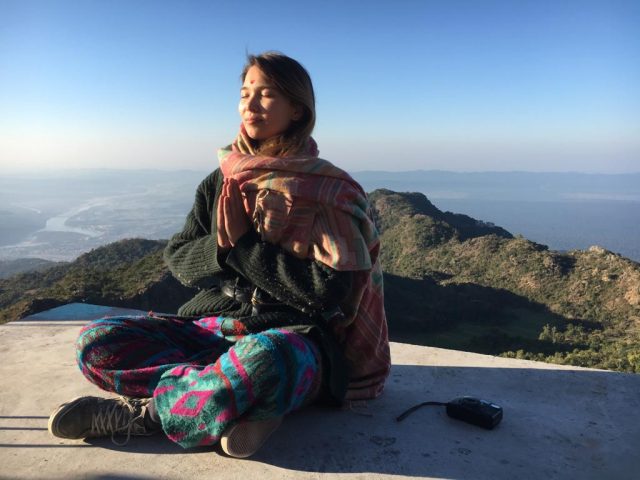
With this we come to the next factor that can greatly contribute to your health and happiness:
Applied breathing techniques, which are practiced to achieve Pranayama, a state in which you do
not have to breathe for an extended time, you can stop breathing for hours and will not die.
According to the teachings of Yoga, you will not die – although you do not breathe or eat – if Prana,
the life force, can flow freely without blockages and all the chakras are activated. In the western
world, Pranayama is often used to describe the exercises themselves, but Pranayama is actually the
name of the state you can achieve by practicing the Pranayama exercises.
„Pran“ means vital energy, life force energy and „Ayama“ means expansion, extension. So
Pranayama is the practice of expanding your life force energy. If you feel f.e. fear your breathing
will become flat and short. If you are under shock, at the first moment you will probably not breathe
at all. But if you breathe deeper and more slowly then you will become calm and relaxed.
Some of the breathing exercises work with breath retentions. Either you hold your breath after finished
inhalation (Antar Kumbhak), or you hold your breath after exhalation (Bahir Kumbhak). Both types
of retention create heat in the body, increase oxygen in the bloodstream, and make your breathing
still, which in return will positively affect your nervous system and calm you down.
At the beginning of the 80s, German doctor Thomas Schmidt conducted a study on yoga teachers
at cologne university. While having them practice the ujjayi breath (a technique where you make a
sound with your glottis when breathing in), they were hooked up to an EEG and it showed alpha
waves, signifying a relaxed state of the brain. Also, these teachers could not be disturbed or affected
by the noise made in the room during their practice.
Another study in the Department of the physiology of S.N. Medical College in Bagalkot showed that 15
days practice of pranayama and meditation significantly reduced resting pulse rate, systolic blood
pressure, and mean arterial blood pressure in healthy people, age 20 – 60, and different BMI. These
are just two examples. Many studies have been done about both the topic Pranayama and meditation
showing various proven health benefits.
Some of the exercises:
– Kapalbhati Pranayama (flapping breath, exhale forcefully rather faster, 10 rapid breaths in
succession, then breathe normally)
Benefits: creates body heat, prepares the mind for meditation, energizes and calms you down at
the same time. 3
– Nadi Shodhana Pranayama (Nadi: channel Shodan: purification)
Nadis are channels through which the pranic forces flow. There are according to the ancient
writings 72000 of them in your body, supplying you with energy. The three main energy channels
are called Ida, Pingla, and Sushumna and are situated around your spine. Sushumna is located in the
center, originating in the mooladhara (root) chakra. Ida flows from the left side in spirals, passing
through every chakra in turn like a criss-cross, Pingala flows from the right to the left. Ida
is introverted and feminine, Pingala is active, extrovert, and masculine. If the airflow through your left
nostril is greater, then Ida is dominant and if the right nostril is more active, then Pingala is
dominant. If both nostrils are equally active, then Sushumna is dominant.
This breathing exercise should balance Ida and Pingala so that Sushumna, which is situated in the
the middle can flow without blockages.
Using a special hand posture, the Nasagra Mudra, in which you take your right hand and pair up
your pinkie and ring finger and your middle and index finger while the thumb is for itself. The thumb
blocks the right nostril, pinkie and ring finger block the left nostril, index and middle finger can lean
on the forehead or be tucked in. In these techniques, you will work with blocking one nostril while
using the other.
– Technique1: Preparatory practice block right nostril, inhale and exhale through left 5
times. Repeat with right nostril while blocking the left. 5 times. Complete the round with
breathing in and out through both nostrils. 5 times. That is one round.
– Technique 2: Alternate nostril breathing.
Breathe in through the left nostril first, blocking the right, then breathe out through the right
nostril while blocking the left. Then, breathe in through the right nostril and out through the left, in
through left and out through right again
– Technique 3: with internal retention (Hold breath after inhalation)
– Technique 4: with internal and external retention
(Hold your breath after inhalation and exhalation
Benefits: Breathing through the right nostril stimulates the left hemisphere of your brain,
breathing through the left nostril stimulates the right hemisphere of the brain. These
exercises, especially 2,3, and 4, balance the brain hemispheres. They have a calming effect
on you, lower blood pressure increases concentration, release stress, supply the body with
more oxygen, activate various centers in the brain, and harmonize the pranas, so Sushumna
can start to flow and can lead to deep states of tranquility.
– Ujjayi breath (psychic breath, making a sound with your glottis when inhaling)
– Benefits: calms the nervous system and slows down the heart rate, good for people with
high blood pressure strengthens the vocal cords.
– Bhramari Pranayama (humming bee breath, block your ears with the thumb, and hum
breathing out, you will hear and feel the sound in your head.)
Benefits: Very soothing to the nervous system since you create a sound you hear in your
head. Relieves stress and strengthens the voice.
Philosophy, the Sutras
The sutras of Patanjali are a collection of 196 short formulas in verse form of philosophical
teachings around Yoga.
The Yoga Sutra has eight limbs and each has several other meanings again. So one formula becomes
loaded with information and wisdom. In ancient times this technique was used so the teachings
were easy to remember. They offer you a great variety of possibilities to implement a healthy
structure in your life that will ultimately bring you and the ones around you more peace, meaning,
health, and happiness in your life.
Yoga sutra:
Yama, Niyama, Asana, P ranayama, Pratya hara, Dharana, Dhyana, Samadhi.
Values like nonviolence, truthfulness, nonstealing, noncollecting (greed), controlling your desires,
practicing abstinence, the importance of cleansing your body and mind from physical and mental
clutter (unhealthy thoughts), the discipline to study by yourself and yourself and many more, hint
towards building a strong foundation for yourself because you will understand why it is valuable to
practice the teachings and they will positively alter your state of mind. Destructive mental or
physical behavior is not tolerated by the teachings. You are not allowed to hurt yourself or others.
They show you a way to deep self-acceptance through understanding life and its challenges more
thoroughly. Everybody around you would benefit from your transformation if you study the sutras
and implement some of their wisdom in your life. I will not go into the full meaning of every word
as it is going to be too much material for this essay.
Shatkarma, cleansing the body

One meaning of „Niyama“ is internal and external purification. It is important to cleanse our bodies
and mind. There are different methods to cleanse your body.
Some of them are:
Jala Neti,
in which you insert the nozzle of a specially designed pot into your one nostril. It is filled with
lukewarm light salty water. You pour the water into one nostril and it comes out through the
other. Rinse each nostril. You have to do some special breathing exercises and postures afterward
to get all the water out.
Benefits: removes mucus, air flows more freely, good for eyes and ears.
Sutra Neti,
here you insert a special thread through one nostril and let it come out through the mouth. Do Jala
Neti before.
Benefits: the regular friction of the thread can remove fleshly outgrowths within a few months.
Otherwise same benefits as Jala Neti
Vaman Dhauti (regurgitative cleansing)
drink 6 to 8 glasses of salt water. Then throw it up again, contracting your stomach and putting
your fingers down your throat.
Benefits: Removes mucus from the stomach, stimulates the abdominal organs, and can help release
pent–up emotions.
Shank Prakshalana
Cleanse the whole digestive tract. Drink two glasses of saltwater as fast as possible. Do a series
of 5 special Asanas which are all easy twists, massaging the water downwards through your
digestive tract. Drink 2 glasses again, then do the Asanas again, and so on. You always alternate
between the drinking and the Asanas without taking any breaks. After a while, you will need the toilet.
Continue drinking water and doing the Asanas until there is no solid matter coming out of your
body anymore. There is a special meal you should have after this procedure. Best to first perform it
in an ashram or with a teacher who knows how to guide you through.
Benefits: Removes mucus from your intestine, heals off inflammatory processes, cleanses the whole
intestinal lining, stimulates the liver and other digestive organs and glands which then again helps
to clean the blood also. Can also improve eyesight and concentration, cloudiness of the mind
disappears, skin issues get better.
Nutrition
You have seen that a lot about the yogic lifestyle is about cleansing and making the body and psyche
pure and strong.
So what we put into our bodies daily of course has a huge impact on the way we feel,
mentally and physically.
Bad eating habits can have a direct influence on your hormone levels, melatonin production,
concentration, blood pressure, blood flow in general, a recreation of brain cells, production of mucus
that can cause a broad range of health issues in the respiratory organs and digestive organs, skin
issues, the list goes on and on.
A big malefactor is a sugar and all that is artificially made of sugar or is a form of it like alcohol.
Sugar directly influences your insulin levels, your adrenalin, and cortisol levels. This causes the
adrenal glands to produce a lot of adrenalin (also caused by caffein) and after a long period of time
leads to their exhaustion. People start feeling tired and exhausted all of the time and find it hard to
concentrate.
This also can have to do with the liver, the biggest detox organ in our body. If the liver gets clogged
up, the bile it produces cannot flow freely into the gallbladder any longer. This causes a too-small
supply of enzymes and the right ph for the intestines. The result is an imbalance of bacteria in the
intestine, the good bacteria start to dwindle and bad bacteria and yeasts start to grow, causing a row
of digestive issues.
So in the yogic lifestyle, you should avoid stimulants of all kinds (sugar, caffeine, nicotine alcohol,
drugs) and meat and eggs. Meat does not only contain a lot of growth hormones and antibiotics
nowadays but also the animal feels fear before it is getting killed. And the corpse becomes stiff.
This stiffness is caused by Adrenalin. And you know what makes the meat soft after a while? The
meat starts to rot. That is why it becomes chewy soft. So the softer the meat – the more rotten it is.
It is apparent why you would not want to put that into your system. You would be eating fear and
death.
According to the sutras, you should not harm any other creature. 150 billion animals are
slaughtered each year worldwide. We owe a lot to the animal kingdom. They are held under cruel
and unworthy conditions. You do not want to be a part of this if you want to live with integrity.
In sattvic nutrition also garlic and onions are avoided. All foods should be freshly prepared and not
be stored in plastic but glass containers.
If we want to include the ayurvedic perspective, then all food that does not last long /withers fast
like leafy greens, cucumber, and veggies containing a lot of water, count as vatta, air food.
Roots and foods like pumpkin and cabbage can be stored longer and are more pitta/vatta
legumes and grains can be stored longest. They would count as Kapha foods.
Try to eat lots of fruit and vegetables, preferably steamed vegetables to make them easier to digest.
Drink hot or warm water or detox tee, try to avoid stimulants and any kind of soft drinks. Try to buy
organic food. If you want to drink plant-based milk, go for almond and/or coconut milk. Try to avoid
soya as its isoflavonoids can have an effect on estrogen levels and there is a high possibility that
you somewhat buy a genetically modified product.
Meditation
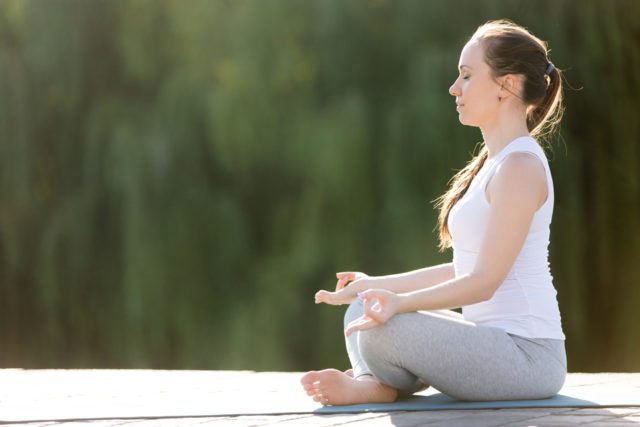
Meditation helps you to be present, to stay in the here and now by turning inward and focus on one
thing without letting yourself be distracted. It helps you to attain mental clarity, emotional balance,
it is helpful to reduce stress, anxiety, and depression to name just a few benefits. I mentioned earlier
that there are many studies to be found about this topic and meditation
has proven benefits for mental and physical health.
Breathing meditation
One of the most simple meditations is observing your breath. You sit with a straight back in a
comfortable seated position, f.e. simple cross-legged, close your eyes and simply observe your
breath. You try to keep your awareness on your breath. Feel the temperature of the breath when it
enters your nostrils as you inhale, and the temperature as you exhale. Feel your chest lifting and
coming down again. Feel where in the body you feel your breath first without changing anything.
Through this meditation, you become an observer of yourself. And if the to-do list of the day comes
into your head or the neighbor you just had a dispute with or the cookies you want to eat – you will
look at those thoughts and let them go again. You do not fight them or suppress them. You simply try
to let them pass you like clouds in the sky. This meditation helps you to keep a healthy distance from
the whirlpool of thoughts and reactive patterns on them or things happening to us in our
environment. You learn to observe but not react immediately. It helps you to learn to stay calm.
Focussing on your breath is effective because you have your breath always with you wherever you
are and whatever you do. So if you get stressed out during your day you can always take a small
break – even if you have to go to the bathroom for this – and focus a few minutes on your breath.
You will feel better after doing this.
Walking meditation
In walking meditation, you inhale when you lift your feet and you exhale when they are on the floor.
Inhale: Lift one thigh approximately parallel to the ground so your lower leg creates almost a 90
degree angle.
Exhale and according to the rhythm of your breathing put your foot on the floor. If you do this really
slowly, challenging the length of your breath and your balance, you will become very focussed and
calm.
Meditation of golden light
You can imagine that you are breathing with your feet. The breath comes up through your feet and
reaches your crown with inhale, and with exhale leaves your body through the feet again.
You can add a golden light to it, with inhale entering your body and cleaning your body, bringing
love, healing, and light.
With exhaling all the negativity, aggression, depression, sadness and bad energies are leaving the
body with you imagining how you exhale black through your feet. Inhale white – golden light up to
your crown, and exhale black again through your feet so it makes you feel as if the whole you get
cleansed.
There are many different forms of meditation. Some of them are also dynamic, meaning they
include movements like dancing or singing mantras or tones. There are plenty of possibilities suiting
every type of human and situation.
They all have one thing in common: They bring you back to yourself, they help you be more
conscious of yourself as you go about your day, in which so many different stimuli and
information is invading your mind and tries to distract you.
Conclusion
As we have seen yoga does not only consist of the Asanas, the body postures. It is a much more
a complex system that offers teachings about a holistic, healthy way of life, addressing not only the
the physical body, but also mental life and spirituality.
If we can include some of these practices in our life daily we can become more aware of
ourselves and others and more grounded and less reactive. We will have a stronger and more
healthy body and mind. Even if you start your day only with a 15 minutes meditation after waking
up each morning, preparing you for your day. You will feel more collected. If you sit the whole day
in the office or car and your job gives you back pain, try to do some Asanas when getting home to
loosen up your muscles again. If you are feeling down, practice some Asanas and you will feel
elevated afterward. Sleep will also be improved. Since Yoga is offering teachings for so many
different parts of you, you will find improvement in your life, whichever practice you do. But do it
regularly. Your decisions will be based on a collected outlook on life, in which you know what is
good for you and thus lead to a better, more grounded life.
Namaste.
